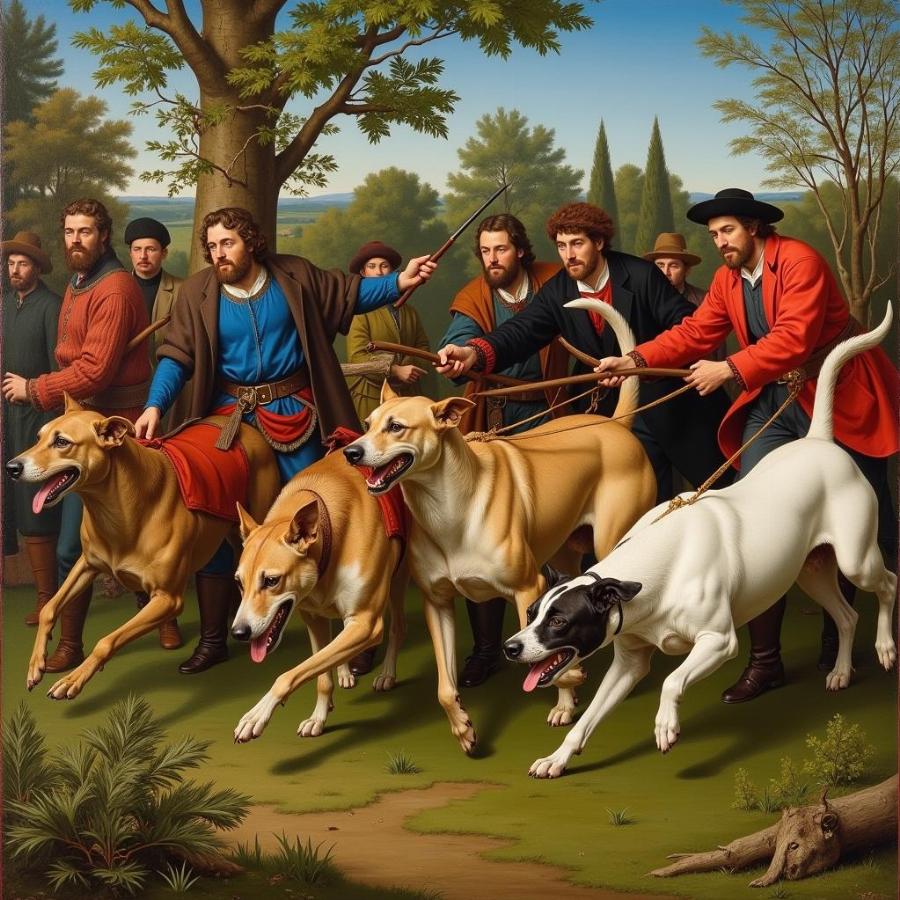Medieval dog paintings offer a fascinating glimpse into the historical relationship between humans and canines. These artworks aren’t just aesthetically pleasing; they reveal much about the roles dogs played in medieval society, the breeds popular at the time, and even the artistic styles of the era. Whether you’re a dog lover, an art enthusiast, or a history buff, exploring the world of medieval dog paintings can be a rewarding experience.
Dogs in Medieval Art: More Than Just Pets
Dogs in medieval art weren’t always depicted as beloved companions curled up by the fire. They were often symbols of loyalty, guardianship, and even hunting prowess. Their presence in paintings could signify the owner’s status, wealth, or even their moral character. Understanding these symbolic meanings adds another layer of appreciation for these historical artworks. For example, hunting scenes frequently featured dogs, highlighting their crucial role in providing food and sport. Similarly, depictions of noblemen with their hounds emphasized the dog’s role as a status symbol.
 Dogs in Medieval Hunting Scene
Dogs in Medieval Hunting Scene
What breeds were popular during this time? While many breeds we know today didn’t exist then, we can see representations of ancestors of modern breeds like mastiffs, hounds, and terriers. These depictions offer valuable insights into the evolution of dog breeds over centuries.
The Symbolism of Dogs in Medieval Paintings
The symbolism associated with dogs in medieval art is rich and complex. Dogs could represent faithfulness, vigilance, and even spiritual guidance. They were sometimes portrayed alongside saints, further emphasizing their positive connotations. In contrast, they could also be used to symbolize negative traits like greed or aggression, particularly in religious contexts depicting sin or temptation.
Did you know that the color of a dog in a medieval painting could also carry symbolic weight? White dogs often represented purity and innocence, while black dogs could be associated with evil or the underworld. These nuanced details highlight the careful consideration artists put into their depictions of dogs.
Where to Find Medieval Dog Paintings
Want to see these amazing artworks for yourself? Museums across Europe house collections of medieval art, providing opportunities to view these canine depictions firsthand. Online databases and digital archives also offer accessible ways to explore this fascinating subject. Resources like the British Library and the Getty Museum have extensive online collections featuring medieval manuscripts and artworks.
What about private collections? While less accessible to the public, many medieval dog paintings remain in private hands, adding an air of mystery to their existence. Perhaps one day, these hidden treasures will be revealed to the world.
Caring for Your Modern-Day Hound
While we admire the dogs of the past, let’s not forget about our furry friends in the present! Just like their medieval counterparts, our modern dogs deserve the best care we can provide.
What food should I feed my dog?
A balanced diet is crucial for a healthy dog. Choose high-quality dog food appropriate for your dog’s breed, age, and activity level. Consult your veterinarian for personalized dietary recommendations.
How much exercise does my dog need?
Regular exercise is essential for both physical and mental well-being. The amount of exercise will vary depending on the breed and age, but daily walks and playtime are a must.
How can I ensure my dog’s safety?
Keeping your dog safe involves various aspects, from proper identification tags and microchipping to ensuring a secure home environment and responsible leash handling.
Conclusion
Medieval dog paintings provide a captivating window into the past, showcasing the enduring bond between humans and dogs. By examining these artworks, we gain a deeper understanding of the historical roles dogs played, the evolution of breeds, and the symbolic meanings associated with these beloved animals. So, next time you admire a painting, take a closer look – you might just discover a fascinating canine companion hidden within the brushstrokes.
FAQ
- Where can I find more information about medieval dog breeds?
- Are there any books dedicated to the subject of animals in medieval art?
- How can I tell if a medieval painting depicts a specific dog breed?
- What were the most common roles of dogs in medieval society?
- Are there any modern-day dog breeds that directly descend from medieval breeds?
- What are some famous examples of medieval dog paintings?
- How did artists depict the relationship between humans and dogs in medieval art?
Further Exploration
- The History of Dog Breeds
- The Role of Animals in Medieval Art
- Famous Medieval Paintings Featuring Dogs
Beaut Dogs is your one-stop destination for all things dog-related. We provide reliable and insightful information on everything from breed characteristics to care tips. When you need assistance, feel free to reach out to us at [email protected] for detailed and accurate answers. Beaut Dogs is here to support you on your journey with your canine companion. Visit us at https://beautdogs.com.